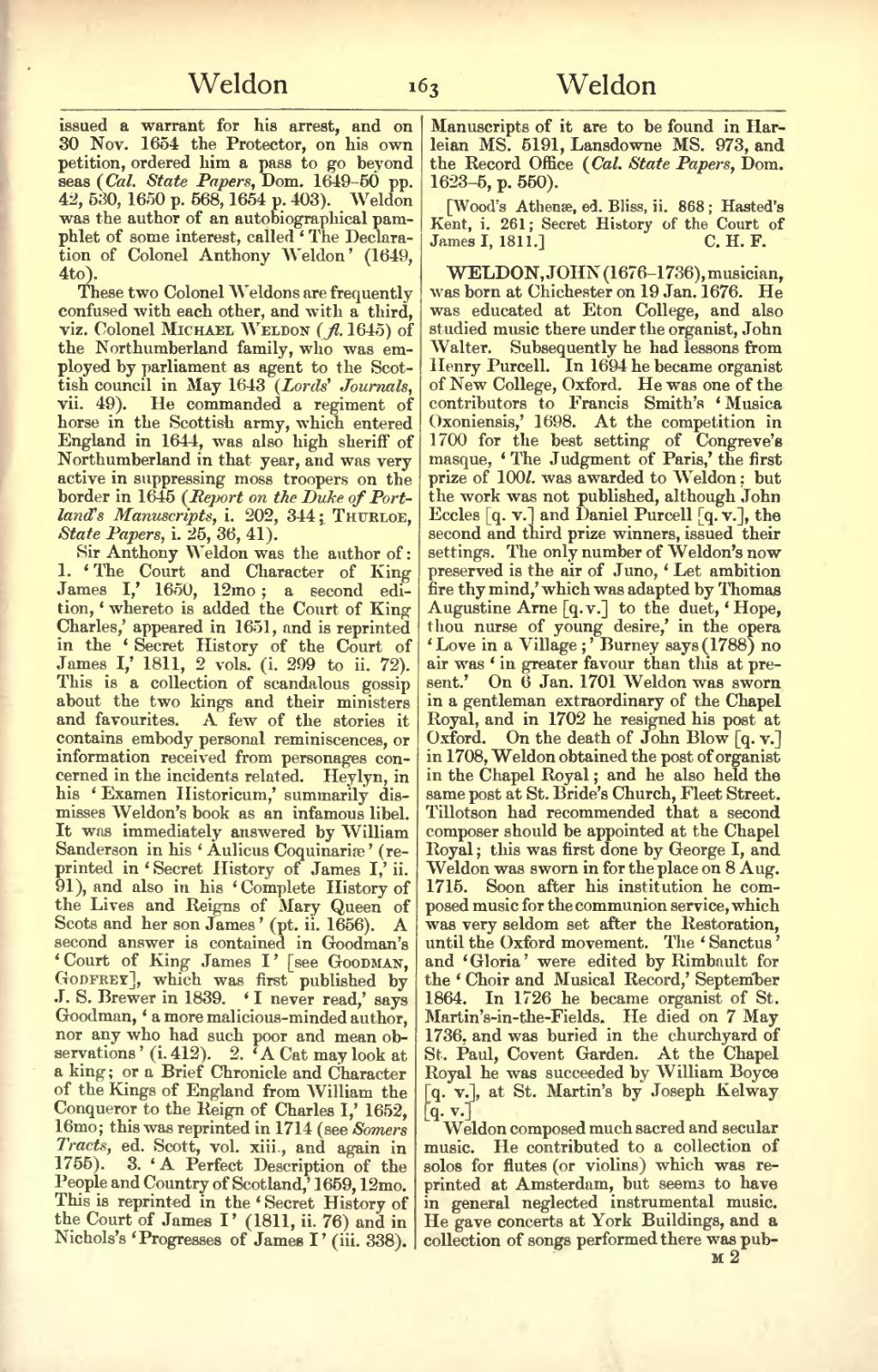issued a warrant for his arrest, and on 30 Nov. 1654 the Protector, on his own petition, ordered him a pass to go beyond seas (Cal. State Papers, Dom. 1649–50 pp. 42, 530, 1650 p. 568, 1654 p. 403). Weldon was the author of an autobiographical pamphlet of some interest, called ‘The Declaration of Colonel Anthony Weldon’ (1649, 4to).
These two Colonel Weldons are frequently confused with each other, and with a third, viz. Colonel Michael Weldon (fl. 1645) of the Northumberland family, who was employed by parliament as agent to the Scottish council in May 1643 (Lords' Journals, vii. 49). He commanded a regiment of horse in the Scottish army, which entered England in 1644, was also high sheriff of Northumberland in that year, and was very active in suppressing moss troopers on the border in 1645 (Report on the Duke of Portland's Manuscripts, i. 202, 344; Thurloe, State Papers, i. 25, 36, 41).
Sir Anthony Weldon was the author of: 1. ‘The Court and Character of King James I,’ 1650, 12mo; a second edition, ‘whereto is added the Court of King Charles,’ appeared in 1651, and is reprinted in the ‘Secret History of the Court of James I,’ 1811, 2 vols. (i. 299 to ii. 72). This is a collection of scandalous gossip about the two kings and their ministers and favourites. A few of the stories it contains embody personal reminiscences, or information received from personages concerned in the incidents related. Heylyn, in his ‘Examen Historicum,’ summarily dismisses Weldon's book as an infamous libel. It was immediately answered by William Sanderson in his ‘Aulicus Coquinariæ’ (reprinted in ‘Secret History of James I,’ ii. 91), and also in his ‘Complete History of the Lives and Reigns of Mary Queen of Scots and her son James’ (pt. ii. 1656). A second answer is contained in Goodman's ‘Court of King James I’ [see Goodman, Godfrey], which was first published by J. S. Brewer in 1839. ‘I never read,’ says Goodman, ‘a more malicious-minded author, nor any who had such poor and mean observations’ (i. 412). 2. ‘A Cat may look at a king; or a Brief Chronicle and Character of the Kings of England from William the Conqueror to the Reign of Charles I,’ 1652, 16mo; this was reprinted in 1714 (see Somers Tracts, ed. Scott, vol. xiii., and again in 1755). 3. ‘A Perfect Description of the People and Country of Scotland,’ 1659, 12mo. This is reprinted in the ‘Secret History of the Court of James I’ (1811, ii. 76) and in Nichols's ‘Progresses of James I’ (iii. 338). Manuscripts of it are to be found in Harleian MS. 5191, Lansdowne MS. 973, and the Record Office (Cal. State Papers, Dom. 1623–5, p. 550).
[Wood's Athenæ, ed. Bliss, ii. 868; Hasted's Kent, i. 261; Secret History of the Court of James I, 1811.]
WELDON, JOHN (1676–1736), musician, was born at Chichester on 19 Jan. 1676. He was educated at Eton College, and also studied music there under the organist, John Walter. Subsequently he had lessons from Henry Purcell. In 1694 he became organist of New College, Oxford. He was one of the contributors to Francis Smith's ‘Musica Oxoniensis,’ 1698. At the competition in 1700 for the best setting of Congreve's masque, ‘The Judgment of Paris,’ the first prize of 100l. was awarded to Weldon; but the work was not published, although John Eccles [q. v.] and Daniel Purcell [q. v.], the second and third prize winners, issued their settings. The only number of Weldon's now preserved is the air of Juno, ‘Let ambition fire thy mind,’ which was adapted by Thomas Augustine Arne [q. v.] to the duet, ‘Hope, thou nurse of young desire,’ in the opera ‘Love in a Village;’ Burney says (1788) no air was ‘in greater favour than this at present.’ On 6 Jan. 1701 Weldon was sworn in a gentleman extraordinary of the Chapel Royal, and in 1702 he resigned his post at Oxford. On the death of John Blow [q. v.] in 1708, Weldon obtained the post of organist in the Chapel Royal; and he also held the same post at St. Bride's Church, Fleet Street. Tillotson had recommended that a second composer should be appointed at the Chapel Royal; this was first done by George I, and Weldon was sworn in for the place on 8 Aug. 1715. Soon after his institution he composed music for the communion service, which was very seldom set after the Restoration, until the Oxford movement. The ‘Sanctus’ and ‘Gloria’ were edited by Rimbault for the ‘Choir and Musical Record,’ September 1864. In 1726 he became organist of St. Martin's-in-the-Fields. He died on 7 May 1736, and was buried in the churchyard of St. Paul, Covent Garden. At the Chapel Royal he was succeeded by William Boyce [q. v.], at St. Martin's by Joseph Kelway [q. v.]
Weldon composed much sacred and secular music. He contributed to a collection of solos for flutes (or violins) which was reprinted at Amsterdam, but seems to have in general neglected instrumental music. He gave concerts at York Buildings, and a collection of songs performed there was pub-
